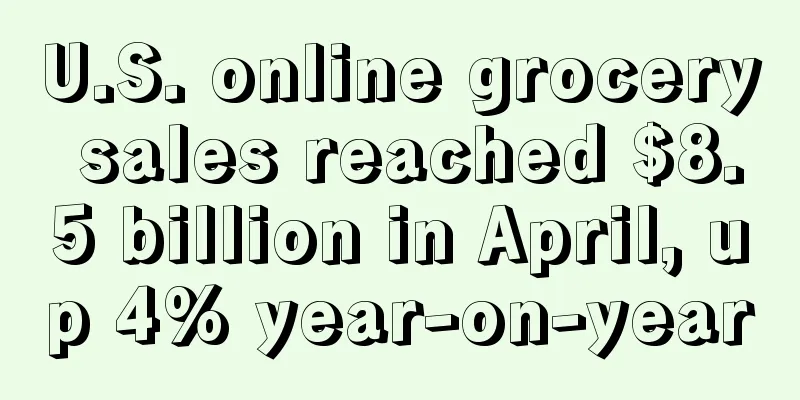U.S. online grocery sales reached $8.5 billion in April, up 4% year-on-year

|
It is learned that on May 14, according to foreign media reports, driven by growth in the delivery field, US online grocery sales increased to US$8.5 billion in April, a year-on-year increase of 4%. According to the latest Brick Meets Click and Mercatus Grocery Shopper Survey, U.S. grocery order frequency declined compared to a year ago as overall penetration remained stable. As a result, sales growth in April was driven primarily by home delivery. Data shows that self-collection sales (customers pick up orders at a designated location) increased by 2.1% year-on-year in April, with average order value (AOV) climbing. The growth was due to the decrease in monthly active users of the service (mainly people over 60 years old) and the decline in order frequency, which was due to the overall higher consumption level. Delivery sales (orders delivered by first-party, third-party vendors or retailer employees) climbed 4.3% in April. The growth in sales was driven by the expansion of monthly active users of the service, as major retailers launched subscription plans and increased penetration among users of all ages. Compared with April 2023, order volume increased, while AOV remained essentially unchanged. Meanwhile, home delivery sales grew 10.2% year-over-year, accounting for 18.7% of online grocery sales, driven by a modest expansion in its monthly active user base. However, a decline in order frequency for home delivery services led to an overall decrease in order volume. Currently, more and more online customers are starting to buy groceries from large retailers. In April 2024, orders provided by large retailers accounted for 51% of the online grocery monthly active user base, an increase of 500 basis points year-on-year. In contrast, in April 2024, orders from supermarket retailers accounted for only 30%, a decrease of 280 basis points year-on-year. Mercatus Chief Growth Officer Mark Fairhurst said that given the shift in consumer purchasing patterns, especially changes in shopping activities between supermarkets and large retailers, grocers need to improve the online and in-store shopping experience through technology investments. Currently, large retailers such as Walmart and Target have invested heavily in their applications, using emerging technologies such as artificial intelligence to enhance their ability to predict and adapt to customer behavior in real time. Author ✎Rayna/ Statement: This article is copyrighted and may not be reproduced without permission. If you need authorization, please contact: happy |
<<: Newegg launches new online store for college students
Recommend
What is Pabbly Email Marketing? Pabbly Email Marketing Review
Pabbly Email Marketing is a premium email marketin...
Consumer purchasing power strengthens! Canadian retail sales overall increased by 1.2% in November!
<span data-shimo-docs="[[20,"获悉,据外媒报道,加拿大零...
What is Cangwang Overseas Warehouse? Cangwang Overseas Warehouse Review
Cangwang Overseas Warehouse is located in Shenzhen...
Shenzhen's big seller has settled in Temu! Is the cross-border battle ready to start?
It is learned that Marketplace Pulse data shows th...
Bad news! Amazon's latest changes! All sellers' products are affected
The sweater war that started last year was in full...
Must read! How do Amazon sellers get reviews?
As a large platform, Amazon has attracted many com...
Beware! These popular products have patents, sellers should check...
1. ORAL IRRIGATOR Overseas consumers generally att...
What is ListingsHistory? ListingsHistory Review
ListingsHistory is an eBay sales analysis tool tha...
US online item prices have fallen for 8 consecutive months! The categories with the biggest drops are...
It is learned that Adobe recently released the lat...
What is OpenCart? OpenCart Review
OpenCart is also a very popular online B2C store o...
What is Droom? Droom Review
Droom is India’s third largest e-commerce company ...
Is there a chance for the "account blocking trend" to reverse? Amazon was ordered to unconditionally unblock seller accounts
▲ Video account attention: cross-border navigation...
The United States will impose an additional 10% tariff on Chinese goods, effective March 4
On February 27, 2025, local time, US President Tru...
Shopify lost $1.2 billion in Q2! Losses are expected to continue in the second half of the year
It is learned that on July 27, Shopify announced i...
Fully open to the shared bikes? TIKTOK’s biggest opportunity is coming!
Sellers who follow TikTok should have heard a piec...









